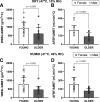Age alters the thermoregulatory responses to extreme heat exposure with accompanying activities of daily living
- PMID: 37410904
- PMCID: PMC10538984
- DOI: 10.1152/japplphysiol.00285.2023
Age alters the thermoregulatory responses to extreme heat exposure with accompanying activities of daily living
Abstract
Older adults are at greater risk for heat-related morbidity and mortality, due in part to age-related reductions in heat dissipating capabilities. Previous studies investigating the impact of age on responses to heat stress used approaches that lack activities of daily living and therefore may not accurately depict the thermal/physiological strain that would occur during actual heatwaves. We sought to compare the responses of young (18-39 yr) and older (≥65 yr) adults exposed to two extreme heat simulations. Healthy young (n = 20) and older (n = 20) participants underwent two 3-h extreme heat exposures on different days: 1) DRY (47°C and 15% humidity) and 2) HUMID (41°C and 40% humidity). To mimic heat generation comparable with activities of daily living, participants performed 5-min bouts of light physical activity dispersed throughout the heat exposure. Measurements included core and skin temperatures, heart rate, blood pressure, local and whole body sweat rate, forearm blood flow, and perceptual responses. Δ core temperature (Young: 0.68 ± 0.27°C vs. Older: 1.37 ± 0.42°C; P < 0.001) and ending core temperature (Young: 37.81 ± 0.26°C vs. Older: 38.15 ± 0.43°C; P = 0.005) were greater in the older cohort during the DRY condition. Δ core temperature (Young: 0.58 ± 0.25°C vs. Older: 1.02 ± 0.32°C; P < 0.001), but not ending core temperature (Young: 37.67 ± 0.34°C vs. Older: 37.83 ± 0.35°C; P = 0.151), was higher in the older cohort during the HUMID condition. We demonstrated that older adults have diminished thermoregulatory responses to heat stress with accompanying activities of daily living. These findings corroborate previous reports and confirm epidemiological data showing that older adults are at a greater risk for hyperthermia.NEW & NOTEWORTHY Using an experimental model of extreme heat exposure that incorporates brief periods of light physical activity to simulate activities of daily living, the extent of thermal strain reported herein more accurately represents what would occur during actual heatwave conditions. Despite matching metabolic heat generation and environmental conditions, we show that older adults have augmented core temperature responses, likely due to age-related reductions in heat dissipating mechanisms.
Keywords: aging; core temperature; sweating.
Conflict of interest statement
No conflicts of interest, financial or otherwise, are declared by the authors.
Figures




Similar articles
-
Increased Air Velocity Reduces Thermal and Cardiovascular Strain in Young and Older Males during Humid Exertional Heat Stress.J Occup Environ Hyg. 2015;12(9):625-34. doi: 10.1080/15459624.2015.1029613. J Occup Environ Hyg. 2015. PMID: 25897617
-
Folic acid supplementation does not attenuate thermoregulatory or cardiovascular strain of older adults exposed to extreme heat and humidity.Exp Physiol. 2018 Aug;103(8):1123-1131. doi: 10.1113/EP087049. Epub 2018 Jun 26. Exp Physiol. 2018. PMID: 29873123 Free PMC article.
-
Age-related differences in heat loss capacity occur under both dry and humid heat stress conditions.J Appl Physiol (1985). 2014 Jul 1;117(1):69-79. doi: 10.1152/japplphysiol.00123.2014. Epub 2014 May 8. J Appl Physiol (1985). 2014. PMID: 24812643 Free PMC article.
-
Effects of thermal stress during rest and exercise in the paediatric population.Sports Med. 1998 Apr;25(4):221-40. doi: 10.2165/00007256-199825040-00002. Sports Med. 1998. PMID: 9587181 Review.
-
How humans adapt to hot climates learned from the recent research on tropical indigenes.J Physiol Anthropol. 2022 Jul 14;41(1):27. doi: 10.1186/s40101-022-00302-3. J Physiol Anthropol. 2022. PMID: 35836266 Free PMC article. Review.
Cited by
-
Sensing the impact of extreme heat on physical activity and sleep.Digit Health. 2024 Mar 24;10:20552076241241509. doi: 10.1177/20552076241241509. eCollection 2024 Jan-Dec. Digit Health. 2024. PMID: 38528970 Free PMC article.
-
Identifying the Optimal Heat Exposure Metric for Predicting the Physiological Response to Dry or Humid Heat Stress in Young and Older Adults: A Randomized Controlled Study.Environ Health Perspect. 2024 Jan;132(1):17701. doi: 10.1289/EHP13733. Epub 2024 Jan 12. Environ Health Perspect. 2024. PMID: 38214893 Free PMC article. Clinical Trial. No abstract available.
-
Brief extreme passive heat exposure leads to elevated biomarkers of systemic inflammation and acute kidney injury in older vs young adults.Eur J Appl Physiol. 2025 Jun 23. doi: 10.1007/s00421-025-05827-w. Online ahead of print. Eur J Appl Physiol. 2025. PMID: 40549207
-
Aging Increases Enterocyte Damage during a 3-Hour Exposure to Very Hot and Dry Heat: A Preliminary Study.Biology (Basel). 2023 Aug 4;12(8):1088. doi: 10.3390/biology12081088. Biology (Basel). 2023. PMID: 37626974 Free PMC article.
-
Wearable device monitoring of HIV health in the face of climate change and weather exposures: protocol for a mixed-methods study.BMJ Open. 2025 Jun 25;15(6):e092307. doi: 10.1136/bmjopen-2024-092307. BMJ Open. 2025. PMID: 40562564 Free PMC article.
References
-
- Coates L, Haynes K, O’Brien J, McAneney J, de Oliveira FD. Exploring 167 years of vulnerability: an examination of extreme heat events in Australia 1844–2010. Environ Sci Pol 42: 33–44, 2014. doi:10.1016/j.envsci.2014.05.003. - DOI
-
- Gisolfi CV, Wenger CB. Temperature regulation during exercise: old concepts, new ideas. Exerc Sport Sci Rev 12: 339–372, 1984. - PubMed
Publication types
MeSH terms
Grants and funding
LinkOut - more resources
Full Text Sources

